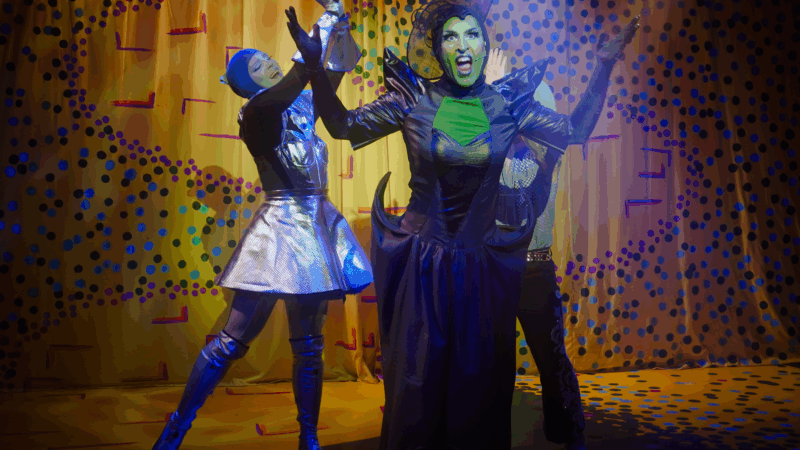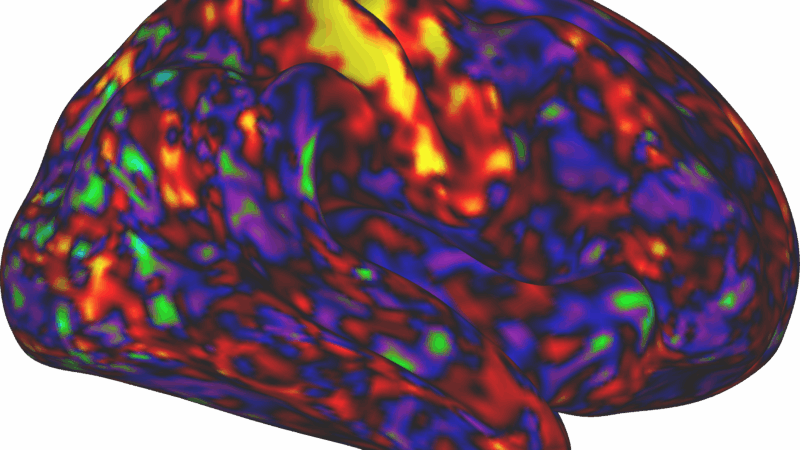To get from experience to emotion, the brain hits ‘sustain’
Get cut off in rush-hour traffic and you may feel angry for the whole trip, or even snap at a noisy child in the back seat.
Get an unexpected smile from that same kid and you may feel like rush hour — and even those other drivers — aren’t so bad.
“The thing about emotion is it generalizes. It puts the brain into a broader state,” says Dr. Karl Deisseroth, a psychiatrist and professor at Stanford University.
Deisseroth and a team of researchers have come up with an explanation for how that happens.
The process involves a signal that, after a positive or negative experience, lingers in the brain, the team reports in the journal Science.
Experiences themselves act a bit like piano notes in the brain. Some are staccato, producing only a brief burst of activity that may result in a reflexive response, like honking at another driver, or smiling back at a child.
But more profound experiences can be more like a musical note that is held with the sustain pedal and still audible when the next note is played, or the one after that.
“You just need it to be sustained long enough to merge with and interact with other notes,” Deisseroth says. “And from our perspective, this is exactly what emotion needs.”
If the team is right, it could help explain the emotional differences seen in some neuropsychiatric conditions.
People on the autism spectrum, for example, often have trouble recognizing emotions in others, and regulating their own emotions. Schizophrenia can cause mood swings and reduced emotional expression.
But some researchers question whether this lingering signal is specific to emotion, a term with no agreed-upon definition in the scientific world.
“Sure, [a sustained signal] happens in emotion,” says Lisa Feldman Barrett, a professor of psychology at Northeastern University. “But it also happens in all kinds of other instances,” like when a person is concentrating or remembering.
Emoting in the lab
Deisseroth and his team set out to recreate the sort of experience that leads to an emotional response, but could be observed in a lab.
“We wanted something that would cause a negative emotion but wouldn’t be painful,” he says.
They chose a puff of air, delivered to the cornea. That meant they could use a machine that eye doctors use to detect glaucoma.
The puff from this device is “certainly annoying, certainly aversive, but not painful,” Deisseroth says.
The team also thought it might provoke the same response in mice, an animal that predates humans by millions of years.
It turned out that both mice and people blink reflexively in response to a puff. Both species also respond to multiple puffs by squinting to protect their eyes.
Next, the team studied the brain activity associated with these experiences. And they found two distinct phases involving different brain circuits.
The first phase is like a staccato note on a piano. In the first two-tenths of a second after a puff, there’s a spike in the activity of brain circuits that process sensory input.
The second phase is more like a piano note held by the sustain pedal. During this period, activity appears in other circuits, including those involved in emotion.
When mice and people were exposed to puffs of air again and again — and again — this sustained response got stronger with each stimulus.
Behavior changed too. Both mice and people squinted more, and the people reported that they were more annoyed by the experience.
“In the mice, although we don’t get those verbal reports, we saw this crucial generalization,” Deisseroth says. “It made them less likely to seek out rewards.”
That behavior, a failure to look for food and other rewards, is a sign of stress or some other negative state in mice.
Enter Ketamine
To confirm the finding, the team did the experiment again. But this time, both mice and people received an anesthetic called ketamine. They thought the drug might disconnect a negative sensory experience from any emotional response it would ordinarily produce.
On ketamine, the second, sustained phase of brain activity was no longer present, and responses to the air puffs changed.
Mice and people would still blink reflexively after a puff of air. But they didn’t squint. And people reported that they no longer found the puffs of air annoying.
“If you remove this sustain phase, you block the emotional response as well,” Deisseroth says.
Sort of, Barrett says.
The study shows that persistent signals in the brain play a role in altering a person or animal’s brain state, she says. But that brain state could be consciousness or focus, rather than an emotion.
Ketamine, she says, interferes with all of these states.
“That tells us that the way that the brain creates emotion is how it creates everything else — how it creates thoughts, how it creates perceptions, how it creates actions,” Barrett says. “It’s not doing something special in emotion.”
Barrett also thinks the air puffs probably mean something different to a mouse than to a person.
“The human brain has this capacity to abstract, to create meanings that go beyond motor and sensory differences,” she says.
Barrett’s concerns about how emotions are studied extends to lots of other research.
The underlying problem, she says, is that scientists have yet to agree on a common definition of an emotion.
Transcript:
ARI SHAPIRO, HOST:
Get cut off in traffic and you might feel angry for the rest of the trip. The experience leads to an emotional response. NPR’s Jon Hamilton reports on a new study of how this process may happen in the brain.
JON HAMILTON, BYLINE: As a psychiatrist at Stanford University, Dr. Karl Deisseroth thinks a lot about how people navigate their emotions.
KARL DEISSEROTH: The thing about emotion is it generalizes. It puts the brain into a broader state.
HAMILTON: So anger at another driver can mean you snap at a noisy child in the back seat. Deisseroth and a team of scientists set out to recreate this sort of experience in the lab.
DEISSEROTH: We wanted something that would cause negative emotion but wouldn’t be painful.
HAMILTON: They chose a puff of air delivered to the cornea. Deisseroth says the experience is like getting a glaucoma test at the eye doctor.
DEISSEROTH: It’s certainly annoying, certainly aversive but not painful. And we thought this also might be something that another mammal would respond to in the same way.
HAMILTON: They tried it on mice. Sure enough, both mice and people blink reflexively in response to a puff. Repeated puffs cause both species to maintain a squint in self-defense. Next, the team studied the brain activity associated with these experiences, and they found two distinct phases involving different areas of the brain. The first phase is fleeting…
(SOUNDBITE OF PIANO PLAYING STACCATO NOTE)
HAMILTON: …Like a staccato note on the piano. During this phase, which lasts a fraction of a second, there’s a spike in the activity of brain circuits that process sensory input. After that, activity moves to other circuits, including those involved in emotion. And this phase lingers…
(SOUNDBITE OF PIANO PLAYING SUSTAINED NOTE)
HAMILTON: …Like a sustained piano note. Deisseroth says that with each successive puff of air, the response got stronger.
(SOUNDBITE OF PIANO PLAYING REPEATED STACCATO NOTES)
DEISSEROTH: You don’t need too long for profound effects to be felt. You just need it to be sustained long enough to merge with and interact with other notes that come after. And from our perspective, this is exactly what emotion means.
HAMILTON: In people, the stronger the brain response, the more they squinted, and the more annoyed they were by the experience.
DEISSEROTH: And the mice, although we don’t get those verbal reports, we saw the same self-protective gesture and we saw this crucial generalization in that it made them less likely to seek out rewards.
HAMILTON: Like food, which is a sign that an animal is stressed. To confirm the finding, the team did the experiment again. But this time, both mice and people received ketamine, an anesthetic that disrupts the brain’s processing of sensory information. On ketamine, mice and people would still blink reflexively after a puff of air, but they didn’t squint. And Deisseroth says the second phase of brain activity was gone.
DEISSEROTH: If you remove this sustained phase, you block the emotion. You block the emotional response as well.
HAMILTON: The study appears in the journal Science. Lisa Feldman Barrett, a professor of psychology at Northeastern University, says it clearly shows how an experience can affect a creature’s underlying mental state. But she says sustained activity in certain brain circuits doesn’t necessarily indicate an emotion.
LISA FELDMAN BARRETT: Sure, that happens in emotion, but it also happens in all kinds of other instances that we experience as other kinds of mental states.
HAMILTON: Like remembering or paying attention. Barrett also thinks the air puffs probably mean something different to a mouse than to a person.
BARRETT: The human brain has this capacity to abstract, to create meanings that go beyond sensory and motor differences.
HAMILTON: Barrett adds that her concerns about this study extend to many others involving the brain states that influence human and animal behavior. The underlying problem, she says, is that scientists still don’t agree on how to define an emotion.
Jon Hamilton, NPR News.
(SOUNDBITE OF AMIE BLU SONG, “EVERYTHING ABOUT HER”)
Disability rights advocate Bob Kafka dead at 79
Bob Kafka was an organizer with ADAPT (American Disabled for Attendant Programs Today), a group which advocates for policy change to support people with disabilities.
‘It’s behind you!’ How Britain goes wild for pantomimes during the holidays
Pantomimes are plays based on a well-known story — often a fairy tale — which are given a bawdy twist. The audience is expected to join in throughout, shouting as loudly as they can.
Kennedy Center vows to sue musician who canceled performance over Trump name change
The Kennedy Center is planning legal action after jazz musician Chuck Redd canceled an annual holiday concert. Redd pulled out after President Trump's name appeared on the building.
Our top global photo stories from 2025: Fearless women, solo polar bear, healing soups
These stunning photos include a polar bear in a Chinese zoo, a teen in Zambia facing an uncertain future, Mongolian kids watching TV in a tent, a chef prepping a bowl of good-for-you soup.
ADHD drugs may work indirectly to boost attention
Drugs like Adderall and Ritalin appear to help children with ADHD by activating brain areas involved in alertness and motivation.
Russia attacks Kyiv, killing 1 and wounding many ahead of Ukraine-US talks
Russia attacked Ukraine's capital with missiles and drones early Saturday morning, killing one and wounding over 20 people a day before talks between Ukraine and the U.S., local authorities said.







